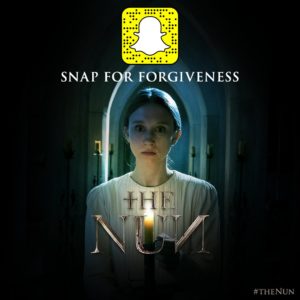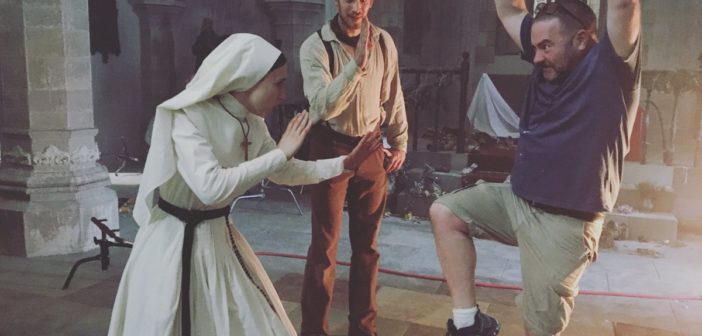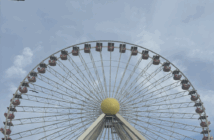Horror films over the last decade have slowly lost their shock values as audiences have become more conscious of jump scares. The newest horror movie, “The Nun” serves as the prequel to the “Conjuring” movie series and is not exempted from the loathsome jump scares.
The film is directed by Corin Hardy (“The Hallow”) and was directed by Peter Safran (2014’s “Annabelle”) and James Wan (The “Saw” franchise). With a production crew as talented as the persons above, it is incredible to see that there were no other creative ways of providing and rallying suspense and fear throughout the film.
The film centers itself around the very real Cârța Monastery that lies on the southern end of Romania in Transylvania. Although the Monastery bears no semblance to the actual effigy in Romania, it presents itself in the same architectural style. The opening of the film shows two nuns walking ominously towards a door with what seems to be a daunting task, the result of which takes the life of one and forces the other to commit an unbelievable act.
The aftermath of the events prompts the Vatican to dispatch Priest, Father Burke (Demián Bichir Nájera- known for his work in the Television show, ‘Weeds’) to investigate. Fr. Burke known for his work on bizarre cases is accompanied by the young novitiate nun Sister Irene (Taissa Farmiga-The Final Girls). The duo is escorted to the site by the only witness to the strange occurrence at the Monastery, a male known as Frenchie (Jonas Bloquet-Valerian and the City of a Thousand Planets). The three then continue what can only be expressed as a “Scooby Doo” quest from the catacombs to the balconies of the Monastery.
On the face of it, the film is very well produced with vivid wide-open shots for landscape establishing scenes, and tightly shot scenes for more suspense filled views gave a great perspective to the film. The setting is 1952 Romania, which calls for a specific style of cinematography which is done well by excluding locations other than the local village outside the convent in question.
Additionally, the portrayal of the Vatican is spot-on as the movie takes its time to establish the clean and bright timbre of the building, which contrasts the dark, murky and ominous convent where most of the film takes place. The attention to detail is appreciated and creates a hyper-realism in this world that draws the audience in throughout the film. Much debate has been centered on the dialog of the film which seems simplistic and bland.
However, the verbiage and rhetoric the characters carry throughout the film juxtapose the period and location perfectly as it’s not a time frame, or a group of individuals exposed to the world as the viewer knows it. Certainly, looking at the film from the perspective of a common villager, nun or priest relegates their discussion to something far less intricate for which some critics of the film pander.

@thenunmovie- The marketing of the film garnered enough support for the movie to triple its budget for opening weekend.
The movie does nothing to recreate scare tactics in the franchise, but it gives great care to the weirding out factor experienced by the audience. The life-like situations the characters are placed in, causes the audience to teeter the line of artificially produced fear and uneasiness more times than one can count. Rooms turn sideways, conveying a vertigo-induced reality and the creature skulks around the halls shrouded in a nun’s garb in a way so similar to real life that after leaving the theater the feelings of discomfort follow you.
“The Nun” wins in the arena of cinematography as it is impossible not to feel the weight of the situations based purely on creative and convincing camera angles. Jump scares detracted from this most times as it was the primary source of building tension as either the music was lowered, or the tempo was increased and abruptly cut by the creature’s appearance. In this regard critics of the film are spot on, the over-reliance of this technique to evoke audiences’ fear is cheap as the novelty wore off years ago.
The pacing of the film, however, was done fairly well. The opening of the film introduces the conflict, and the solution is presented within the first 30 minutes. However, the script falters as there is no clear motivation behind the protagonists’ choice to stay in their predicament. Arguably though, the simple time frame and character arcs of the individuals provide a significant enough cause to not question their motives or lack within the movie’s plot. Volleying their arcs as the reasoning behind fighting the demonic force was enough for the novice horror movie watcher. However, more seasoned viewers crave something new and more fulfilling each time which may not satisfy their hunger.
The score of the movie doesn’t feel original despite its authenticity composed by Abel Korzeniowski being released Aug. 31, a week before the film. With a production budget of $22 million and an opening weekend that garnered an excess of $131 million, lovers of the franchise are flocking to the theatres despite scathing reviews. Movie aggregate Rotten Tomatoes, as of Aug. 9, 2018, has pegged the movie as Certified Fresh with a critic score of 87 percent and an audience score of 70 percent with comments rallying the support of the film. However other aggregates like IMDB give “The Nun” a 6.6 out 10 rating with scathing reviews like, “[The Nun] is a piece of salacious garbage-sponsajesus.”
Regardless, of the viewers’ status of either continuity junky or horror, thrill seeker, “The Nun” is not as disappointing as some would portray it to be.
4 out of 5 Paws.
Check out The Lions’ Pride Watch review of the Nun on Youtube! https://www.youtube.com/watch?v=zzIcahxI4Sk





